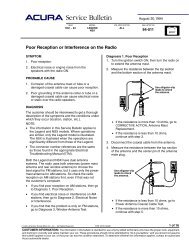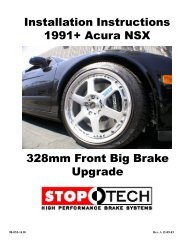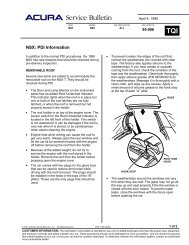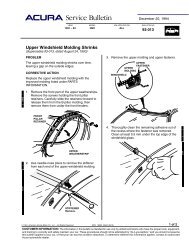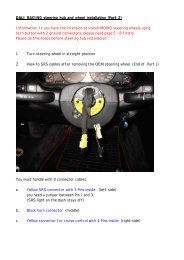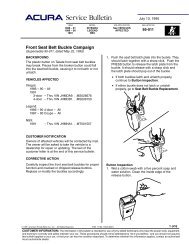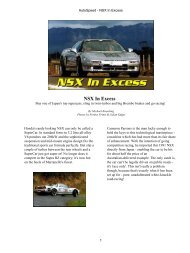R-134a Refrigerant A/C System - Dali Racing
R-134a Refrigerant A/C System - Dali Racing
R-134a Refrigerant A/C System - Dali Racing
You also want an ePaper? Increase the reach of your titles
YUMPU automatically turns print PDFs into web optimized ePapers that Google loves.
September 29, 1992<br />
YEAR MODEL VIN APPLICATION BULLETIN NO.<br />
1993 NSX<br />
LEGEND<br />
ALL<br />
92-027<br />
R-<strong>134a</strong> <strong>Refrigerant</strong> A/C <strong>System</strong><br />
Starting with the 1993 NSX and Legends, Acura will<br />
begin equipping cars with R-<strong>134a</strong> refrigerant A/C<br />
systems. The refrigerant R-12 used in car air<br />
conditioners contains CFCs. Consequently, R-12<br />
refrigerant will be phased out and replaced with the<br />
new refrigerant, R-<strong>134a</strong>, which does not contain CFCs.<br />
Air conditioners using R-<strong>134a</strong> look similar to the<br />
existing R-12 air conditioners in terms of system<br />
structure. The most significant difference is the<br />
refrigerant itself. This Service Bulletin explains the<br />
differences between R-12 and R-<strong>134a</strong> air conditioner<br />
systems, how to identify the system components, and<br />
how to service the R-<strong>134a</strong> air conditioner system.<br />
NOTE: Always refer to the service manual for specific<br />
model information and procedures.<br />
Service Precautions<br />
Observe the following service precautions carefully<br />
when servicing R-<strong>134a</strong> air conditioner systems:<br />
Only use service equipment that is U.L.-listed and is<br />
certified to meet the requirements of SAE J2210<br />
(1991) to remove R-<strong>134a</strong> from the air conditioner.<br />
CAUTION: Exposure to air conditioner refrigerant<br />
and lubricant vapor or mist can irritate eyes,<br />
nose, and throat. Avoid breathing air conditioner<br />
refrigerant and lubricant vapor or mist.<br />
If accidental system discharging occurs, ventilate<br />
work area before resuming service. Additional health<br />
and safety information may be obtained from the<br />
refrigerant manufacturers.<br />
<strong>Refrigerant</strong>s and Oils<br />
<strong>Refrigerant</strong>s R-12 and R-<strong>134a</strong> are not compatible<br />
with each other; do not mix them. Mixing R-12 and<br />
R-<strong>134a</strong> together even in the smallest quantities can<br />
result in air conditioner system and service<br />
equipment failure.<br />
The refrigerant oils are also not compatible. R-12<br />
refrigerant oil is mineral based. R-<strong>134a</strong> refrigerant<br />
uses a Polyalkylene glycol (PAG) synthetic-based oil.<br />
Mixing refrigerant oils will cause compressor failure.<br />
Use only the recommended oil for the compressor.<br />
Refer to the appropriate year and model of service<br />
manual for the specific type of refrigerant oil.<br />
R-<strong>134a</strong> refrigerant and oil both have high<br />
hygroscopic properties, meaning they attract and<br />
absorb moisture rapidly. Observe the following<br />
instructions carefully:<br />
1. When replacing or disconnecting refrigerant lines,<br />
be sure to plug or cap the lines and ports<br />
immediately to keep moisture and dust out of the<br />
system.<br />
2. Before recharging the system, add the same<br />
amount of refrigerant oil removed during the<br />
recovery procedure. Always use new oil from a<br />
sealed container. Do not put used oil back in the<br />
container or the A/C system.<br />
3. Immediately after using the refrigerant oil, replace<br />
the cap on the container to avoid moisture<br />
absorption.<br />
Service Equipment<br />
R-<strong>134a</strong> service equipment or vehicle air conditioner<br />
systems should not be pressure-tested or leak-tested<br />
with compressed air.<br />
Some mixtures of air and R-<strong>134a</strong><br />
have been shown to be combustible at elevated<br />
pressures and can result in fire or explosion,<br />
causing injury or property damage. Never use<br />
compressed air to pressure-test R-<strong>134a</strong> service<br />
equipment or vehicle air conditioner systems.<br />
Additional health and safety information may be<br />
obtained from the refrigerant and lubricant<br />
manufacturers.<br />
Always use a recovery/recycling/charging system<br />
that is U.L.-listed and certified to meet the<br />
requirements of SAE J2210 (1991) when servicing<br />
R-<strong>134a</strong> air conditioner systems.<br />
If a vacuum pump is used for evacuation in place of a<br />
recovery/recycling/charging system, the vacuum<br />
pump must be equipped with a check valve to<br />
prevent the pump oil from backflowing into the air<br />
conditioner system.<br />
Only use manifold gauges and related parts that are<br />
specially designed for R-<strong>134a</strong> (pressure gauges,<br />
hoses, joints, fittings, etc.). Do not try to interchange<br />
parts from R-12 equipment.<br />
© 1992 American Honda Motor Co., Inc. – All Rights Reserved BTB 15361 (9209)<br />
1 of 8<br />
CUSTOMER INFORMATION: The information in this bulletin is intended for use only by skilled technicians who have the proper tools, equipment,<br />
and training to correctly and safely maintain your car. These procedures should not be attempted by “do-it-yourselfers,” and you should not assume<br />
this bulletin applies to your car, or that your car has the condition described. To determine whether this information applies, contact an authorized<br />
Acura automobile dealer.
<strong>Refrigerant</strong> Comparison<br />
R-<strong>134a</strong> R-12<br />
International Designation<br />
International Designation<br />
HFC-<strong>134a</strong><br />
CFC-12<br />
Hydrofluorocarbon<br />
Chlorofluorocarbon<br />
Chemical Formula<br />
Chemical Formula<br />
CH 2 FCF 3<br />
CCl 2 F 2 (contains chlorine)<br />
Container Fitting Size<br />
Container Fitting Size<br />
1/2” - 16 ACME 1/4” Flare (7/16” - 20 UNF)<br />
Container Color<br />
Container Color<br />
Light Blue<br />
White<br />
Boiling Point<br />
Boiling Point<br />
-15.07°F (-26.3°C)<br />
-21.62°F (-29.8°C)<br />
Ozone Depletion Potential<br />
Ozone Depletion Potential<br />
0.0 1.0<br />
Global Warming Potential<br />
Global Warming Potential<br />
Less than 0.3 3.0<br />
R-<strong>134a</strong> <strong>Refrigerant</strong> Suppliers<br />
SUVA TRANS A/C: KLEA:<br />
IG-LO, INC.<br />
ICI Chemicals & Polymers<br />
3499 Dabney Drive, Technical Chemical Co.<br />
Lexington, KY 40509 10737 Spangler Road<br />
1-800-354-9061 or Dallas, TX 75220<br />
1-606-264-7208 1-800-527-0885<br />
FAX 1-606-264-7914 FAX 214-506-7493<br />
NOTE: Only use automotive-type R-<strong>134a</strong> refrigerants<br />
to ensure hardware compatibility.<br />
<strong>Refrigerant</strong> Recovery/Recycling/Charging Center:<br />
Minimum Requirement<br />
The equipment must be U.L.-listed and certified to<br />
meet the requirements of SAE J2210 (1991) for<br />
servicing R-<strong>134a</strong> air conditioner systems.<br />
Reason for New Tool<br />
<strong>Refrigerant</strong>s are not compatible, requiring separate<br />
equipment. Service couplers, thread diameters, and<br />
purity standards for recycled refrigerant are all<br />
different.<br />
Known Suppliers and Model Numbers<br />
White Industries #01090; Kent-Moore #ACR4;<br />
Robinair #34700; Sun #MRC450<br />
2 of 8<br />
R-<strong>134a</strong> Service Tools<br />
Leak Tester:<br />
Minimum Requirement<br />
The leak tester must be able to detect a leak as small<br />
as 0.5 oz. per year or better.<br />
Reason for New Tool<br />
R-<strong>134a</strong> refrigerant cannot be detected with an R-12<br />
type leak tester. R-<strong>134a</strong> refrigerant can only be<br />
detected with a high-sensitivity tester.<br />
NOTE: Most leak testers for R-<strong>134a</strong> refrigerant can<br />
be used for R-12 refrigerant as well.<br />
Known Suppliers and Model Numbers<br />
CPS #L-780a (Matco Tools #AC-750) & #L-790a;<br />
Hitech #HI300TEL & #HI400ATEL; TIF #5050,<br />
#5550, & #5650
R-<strong>134a</strong> / R-12 Air Conditioning Comparison Chart<br />
NOTE: R-<strong>134a</strong> and R-12 parts are not interchangeable. Be sure to use the correct parts for the specified<br />
refrigerant to avoid refrigerant leaks or A/C system failure.<br />
Compressor<br />
R-<strong>134a</strong> R-12<br />
Identification<br />
USE ONLY ND-8 OIL<br />
NOTE: The compressor used on the R-<strong>134a</strong> air<br />
conditioning system has an identification label. Do<br />
not substitute R-12 parts for R-<strong>134a</strong> parts; you may<br />
damage the A/C system.<br />
Compressor Seal<br />
R-<strong>134a</strong> R-12<br />
Seal Material<br />
Seal Material<br />
H-NBR<br />
NBR<br />
(Hydrogenated Nitryl Butadiene Rubber)<br />
(Nitryl Butadiene Rubber)<br />
Reason for Change<br />
The NBR type seals used on the R-12 compressors<br />
will swell and deteriorate rapidly with R-<strong>134a</strong><br />
refrigerant, causing refrigerant leaks.<br />
3 of 8
Compressor <strong>Refrigerant</strong> Oil<br />
R-<strong>134a</strong> R-12<br />
Compressor Manufacturer<br />
Compressor Manufacturer<br />
Nippondenso (ND)<br />
Nippondenso (ND)<br />
<strong>Refrigerant</strong> Oil Type<br />
<strong>Refrigerant</strong> Oil Type<br />
Polyalkylene glycol (PAG)<br />
Mineral oil<br />
Synthetic oil<br />
Oil Name<br />
Oil Name<br />
ND-8<br />
R-12 refrigerant oil<br />
Reason for Change<br />
The oil used for R-12 type compressors does not mix<br />
with R-<strong>134a</strong> refrigerant, causing poor lubrication and<br />
compressor failure.<br />
NOTE:<br />
• Refer to the appropriate year and model of service<br />
manual, or the compressor for the specific type of<br />
refrigerant oil.<br />
• Replacement compressors are prefilled with<br />
R-<strong>134a</strong> refrigerant oil. Additional refrigerant oil is<br />
not necessary.<br />
Compressor Clutch<br />
R-<strong>134a</strong> R-12<br />
Increased capacity<br />
Reason for Change<br />
The normal operating pressure for R-<strong>134a</strong> is higher<br />
than R-12, requiring a larger force to compress the<br />
refrigerant.<br />
Compressor Relief Valve<br />
R-<strong>134a</strong> R-12<br />
Identification<br />
Identification<br />
“A” MARK<br />
2 LINES<br />
10 M X 15 3/8 – 24 UNF<br />
Reason for Change<br />
The pressure setting was changed because R-<strong>134a</strong><br />
has a higher operating pressure than R-12. The relief<br />
valve only releases refrigerant when the pressure is<br />
abnormally high, then resets itself to prevent total<br />
discharge of refrigerant into the atmosphere.<br />
4 of 8
Charge Valve<br />
R-<strong>134a</strong> R-12<br />
Dimension<br />
Dimension<br />
High-pressure side Low-pressure side High-pressure side Low-pressure side<br />
3/8 – 24 UNF 7/8 – 24 UNF<br />
M10 x 1.25<br />
M9 x 1.0<br />
Identification<br />
Cap color: light blue<br />
Identification<br />
Cap color: dark red or black<br />
Service Hose Couplers<br />
Service Hose Couplers<br />
HIGH SIDE:<br />
I.D. 16 mm<br />
HIGH SIDE:<br />
RED KNOB<br />
With High-side<br />
Adapter.<br />
LOW SIDE:<br />
I.D. 13 mm<br />
LOW SIDE:<br />
BLUE KNOB<br />
Reason for Change<br />
To prevent charging the system with the wrong type<br />
of refrigerant.<br />
Condenser<br />
R-<strong>134a</strong> R-12<br />
The heat exchange performance of the condenser<br />
was increased by decreasing the tubing thickness<br />
and increasing the number of loops in the metal<br />
tubing.<br />
Reason for Change<br />
Because the boiling point for R-<strong>134a</strong> is lower than<br />
R-12, the cooling capacity of the condenser was<br />
increased.<br />
5 of 8
Receiver/Dryer<br />
R-<strong>134a</strong> R-12<br />
Desiccating Agent<br />
Desiccating Agent<br />
Improved Zeolite or XH-9<br />
Silica gel or XH-5<br />
Identification<br />
NSX<br />
LEGEND<br />
Identification<br />
9/16 – 18 UNF<br />
M 16 X 1.5<br />
9/16 – 18 UNF<br />
MELTING BOLT<br />
NOTE:<br />
• The NSX R-<strong>134a</strong> receiver/dryer has inch threads,<br />
therefore requiring an identification label. The<br />
Legend receiver/dryer has metric threads with no<br />
label. Do not substitute R-12 parts for R-<strong>134a</strong> parts.<br />
• The desiccant absorbs moisture rapidly, do not<br />
remove the plugs from the receiver/dryer until just<br />
before replacement; keep the plugs on during disassembly.<br />
Reason for Change<br />
R-<strong>134a</strong> absorbs more moisture than R-12. The<br />
desiccant material was changed to achieve better<br />
water absorption capacity. The melting bolt was also<br />
eliminated to prevent a total discharge of refrigerant<br />
into the atmosphere.<br />
Piping<br />
R-<strong>134a</strong> R-12<br />
Identification<br />
Identification<br />
NSX<br />
O-RING: H-NBR<br />
O-RING: NBR<br />
(inch threads)<br />
LEGEND<br />
“0R<strong>134a</strong>” LABEL<br />
O-RING: H-NBR<br />
(inch threads)<br />
(metric threads)<br />
NOTE: The NSX R-<strong>134a</strong> piping has inch threads,<br />
therefore requiring an identification label. The Legend<br />
piping has metric threads with no label. Do not<br />
substitute R-12 parts for R-<strong>134a</strong> parts.<br />
Reason for Change<br />
R-<strong>134a</strong> refrigerant requires the H-NBR type O-rings<br />
to to seal the pipe fittings.<br />
6 of 8
Sealing O-rings<br />
R-<strong>134a</strong> R-12<br />
O-ring Material<br />
O-ring Material<br />
H-NBR<br />
NBR<br />
(Hydrogenated Nitryl Butadiene Rubber)<br />
(Nitryl Butadiene Rubber)<br />
NOTE: The replacement O-rings have an R-<strong>134a</strong><br />
identification label on the parts package only. Keep<br />
the O-ring in the parts package until just before<br />
installing to avoid confusion. Do not substitute R-12<br />
parts for R-<strong>134a</strong> parts, you may damage the A/C<br />
system.<br />
Reason for Change<br />
The NBR type O-rings used on the R-12 systems will<br />
swell and deteriorate rapidly with R-<strong>134a</strong> refrigerant,<br />
causing refrigerant leaks.<br />
Evaporator<br />
R-<strong>134a</strong> R-12<br />
Identification<br />
Identification<br />
NSX<br />
LEGEND<br />
“R<strong>134a</strong>” LABEL<br />
(inch threads)<br />
(metric threads)<br />
(inch threads)<br />
NOTE: The NSX R-<strong>134a</strong> evaporator has inch<br />
threads, therefore requiring an identification label.<br />
The Legend evaporator has metric threads with no<br />
label. Do not substitute R-12 parts for R-<strong>134a</strong> parts.<br />
Reason for Change<br />
Because R-<strong>134a</strong> has a higher pressure load than R-12.<br />
Expansion Valve<br />
R-<strong>134a</strong> R-12<br />
Identification<br />
Identification<br />
NSX<br />
“R<strong>134a</strong>” LABEL<br />
LEGEND<br />
(inch threads)<br />
(metric threads)<br />
(inch threads)<br />
NOTE: The NSX R-<strong>134a</strong> expansion valve has inch<br />
threads, therefore requiring an identification label. The<br />
Legend expansion valve has metric threads with no<br />
label. Do not substitute R-12 parts for R-<strong>134a</strong> parts.<br />
Reason for Change<br />
The set pressure for the expansion valve was changed<br />
because R-<strong>134a</strong> has a higher operating pressure.<br />
7 of 8
Pressure Switch<br />
R-<strong>134a</strong> R-12<br />
Identification<br />
Identification<br />
ALUMINUM<br />
O-RING: H-NBR<br />
M11 x 1.0<br />
STEEL (GOLD COLORED)<br />
O-RING: NBR<br />
3/8 – 24 UNF<br />
Reason for Change<br />
R-<strong>134a</strong>’s normal operating pressure is higher than<br />
R-12. The opening pressure for the valve was<br />
changed so the cooling of the R-<strong>134a</strong> A/C system<br />
would equal an R-12 system.<br />
Hose<br />
R-<strong>134a</strong> R-12<br />
Identification<br />
Identification<br />
EPDM<br />
PET<br />
CL-IIR<br />
6-12NY (NYLON)<br />
PET<br />
EPDM<br />
EPDM<br />
NSX<br />
“R<strong>134a</strong>” label<br />
LEGEND<br />
(inch threads) (metric threads) (inch threads)<br />
8 of 8<br />
FLANGE TYPE SEAL SHAFT TYPE SEAL FLANGE TYPE SEAL<br />
NOTE: The NSX rubber hoses (suction and<br />
discharge) for the R-<strong>134a</strong> air conditioning system<br />
have inch threads, therefore requiring identification<br />
labels. The Legend rubber hoses have metric threads<br />
with no labels. Do not substitute R-12 parts for<br />
R-<strong>134a</strong> parts, you may damage the A/C system.<br />
Reason for Change<br />
The material for the hoses was changed to reduce the<br />
escaping of refrigerant and the entry of moisture<br />
through the hose.



![Keyless Remote Manual [pdf] - Dali Racing](https://img.yumpu.com/49994721/1/190x245/keyless-remote-manual-pdf-dali-racing.jpg?quality=85)
